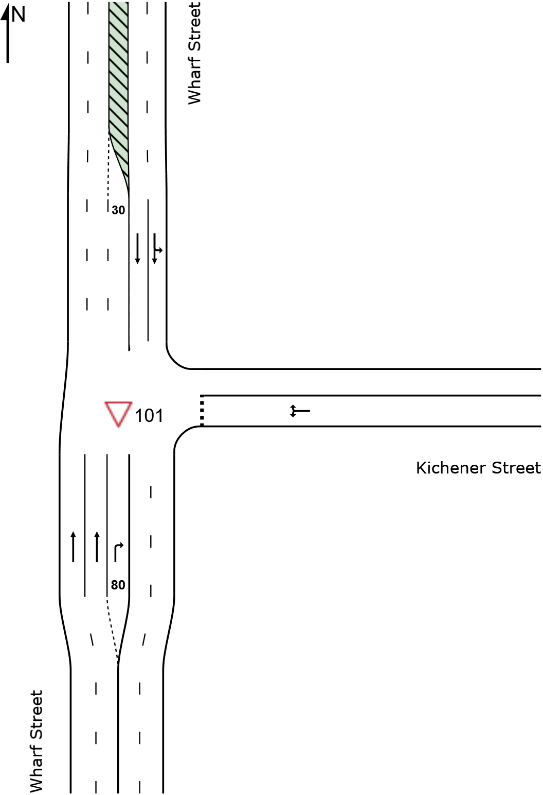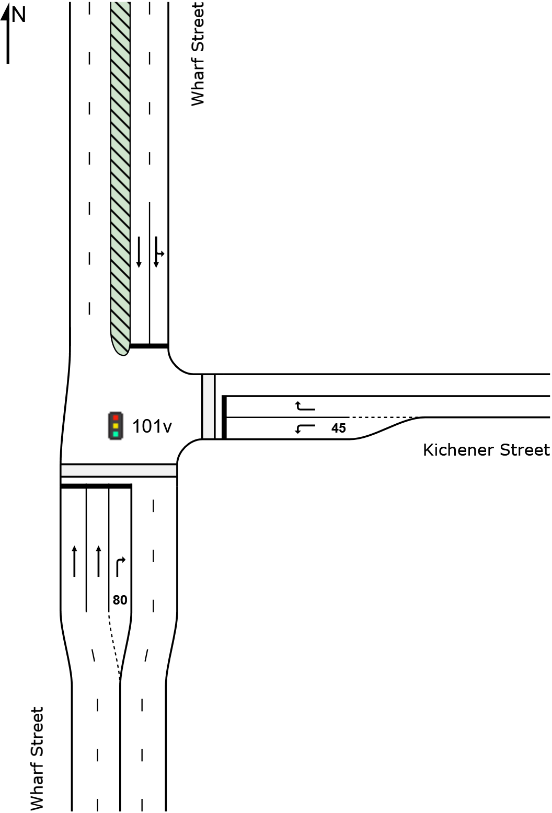

20 May 2020
To
Copy to
Ian Robertson, Sean Neilson
From
Shruti Gadgil
Tel
+64 27 616 2269
Subject
Wharf Street/Kitchener Street Intersection Modelling Job no. 51/12513123
1
Introduction
Further to the 2016 report provided by TDG outlining the different options to increase efficiency at Wharf
Street/ Kitchener Street intersection, Dunedin City Council have commissioned GHD in 2020 to review
and conduct further modelling at this intersection to understand delays and queue length changes
caused by signalising the intersection.
In order to understand the impacts of installing new signals at Wharf Street/ Kitchener Street intersection,
traffic models of the existing intersection and the proposed option were developed in SIDRA. These
models were then evaluated to determine quantitatively the operational difference between current layout
and the proposed new layout.
2
Existing Network Modelling
2.1
Existing Intersection Layout
Wharf Street is a two lane each way regional road with a wide median with an average ADT of 16,900
(2019, Mobile Roads) vehicles per day. Kitchener Street is a one-lane two way urban road with a cycle
and kerbside parking and an average ADT of 765 vehicles (2019, Mobile Roads)
The SIDRA intersection model of the existing intersection layout is shown in Figure 1 below.
 Figure 1 - Existing Intersection Layout
2.2
Assumptions and Exclusions
Figure 1 - Existing Intersection Layout
2.2
Assumptions and Exclusions
The following assumptions and exclusions have been made for this analysis:
Have not allowed for network modelling or intersection with adjacent intersections.
Have modelled existing lane configurations based on latest available aerials.
Only intersections shown in Figure 1 are modelled in SIDRA.
Only the peak periods were modelled. These numbers were extracted from the TDG report provided
to GHD.
No queue length data was available hence; gap acceptance values were modified to replicate on-site
observations.
Right turning vehicles from Kitchener Street were assumed to be using the central median on Wharf
Street and hence a merging lane has been provided in the model as show in Figure 1.
Excluded any cyclist count in the modelling.
2.3
Traffic Counts and Model ed Periods
Dunedin City Council provided GHD with traffic counts conducted on Wharf Street for the first week of
April 2019 (Easter was at the end of the second week of April). However, the TDG report uses volumes
that are higher than these traffic volumes. These flows have been increased by 5% on Kitchener Street
and 30% increase on Wharf Street to allow for growth and uncertainty in turning volumes. For the
modelling of this intersection, only peak periods have been considered.
2.4
Model ing Parameters
Lane widths and short turn lane lengths have been configured to match aerials.
2
link to page 4

SIDRA reduced gap acceptance parameters gave been used for the un-signalised intersection. A
reduction of 30% to the default gap acceptance parameters has been used only for PM traffic flows
to accurately replicate on-site conditions.
SIDRA default gap acceptance parameters have been used for the signalised movements.
60 km/h entry and exit speeds for vehicles along Wharf Street and 50 km/hr entry and exit speeds for
Kitchener Street.
Yellow time of 4 seconds, and all red time of 1 second.
Arrival type has been set as "4 - favourable" rather than "3-isolated" for the northbound approach to
the traffic signals on Wharf Street due to the proximity of the traffic signals at Strathallan Street.
3
Proposed Signalised Intersection
3.1
Proposed Intersection Layout
Figure 2 below shows the proposed intersection layout once signalised.
Figure 2: Proposed Signalised Intersection Layout
3.2
Proposed Intersection Phasing
SCATS phasing sequence have been adopted for the network models as il ustrated i
n Figure 3.
3
link to page 5
 Figure 3: Option Network Phase Sequence
Figure 3: Option Network Phase Sequence
Optimum cycle time and phase splits determined by SIDRA for the option networks are il ustrated in
Appendix A.
SIDRA cycle time option was set to user given phase times. SCATS average cycle time and phase splits
were adopted as a base and adjusted to achieve model validation.
3.3
Calibration
No calibration can be undertaken for this intersection due to lack of queue length survey data. Hence,
default SIDRA values have been used for this analysis.
4
Network Performance comparison
For the signalised intersection, the following optimum cycle times have been used for the signalised
option:
•
Morning Peak: Optimum cycle time of 76 seconds
•
Evening Peak: Optimum cycle time of 98 seconds
4.1
Morning Peak Comparison (Existing and Signalised Option)
Existing and proposed intersection performance is tabulated in
Table 1 and Table 2 below.
4
Table 1: Network Performance - Morning Peak (Existing and Option)
Morning Peak
Existing Network
Option 1
Approach/Movement
Average
95%
Average
95%
Delay
LOS Back of Delay LOS Back of
(Seconds)
Queue
Queue
(veh) (Seconds)
(veh)
Through
0 LOS A
0
1 LOS A
4
Right
12 LOS B
1
38 LOS D
4
South: Wharf Street Approach
1 NA
1
3 LOS A
4
Left
7 LOS A
1
25 LOS C
1
Right
24 LOS C
1
43 LOS D
2
East:Kitchener Street Approach
15 LOS C
1
33 LOS C
2
Left
6 LOS A
0
17 LOS B
9
Through
0 LOS A
0
12 LOS B
9
North: Wharf Street Approach
0 NA
0
12 LOS B
9
All Vehicles
1 NA
1
5.6 LOS A
9
The AM model ing illustrates that South Wharf Street right turn movement performs at LOS D with the
signals incorporated. The highest delays for this intersection are seen at Kitchener Street right turning
movements. There is an overall increase of 18 seconds delay to that movement.
Overall, at the AM peak period, the intersection performs at a LOS A with the signals options.
4.2
Evening peak comparison
Table 2: Option Network Performance - Evening Peak
Evening Peak
Existing Network
Option 1
Average
95% Average
95%
Approach/Movement
Delay
Back of Delay
Back of
(Second
LOS
Queue (Second
LOS
Queue
s)
(veh)
s)
(veh)
Through
0 LOS A
0
0 LOS A
1
Right
47 LOS E
1
56 LOS E
1
South: Wharf Street Approach
1 NA
1
2 LOS A
5
Left
30 LOS D
5
43 LOS D
6
Right
55 LOS F
5
60 LOS E
5
East:Kitchener Street Approach
41 LOS E
5
51 LOS D
5
Left
6 LOS A
0
17 LOS B
33
Through
0 LOS A
0
11 LOS B
33
North: Wharf Street Approach
0
NA
0
11
LOS B
33
All Vehicles
3 NA
4.8
10 LOS B
33.3
5
The PM modelling il ustrates that southbound Wharf Street vehicles wil have an increase of 33 vehicles
queued. Queueing and delays are expected for the intersections through movements as this movement
is now signalised. However, at present there are traffic lights located at Strathallan Street already. Site
observations show queuing from Strathallan Street past Kitchener Street at peak hours. Hence, the
addition of signals at Kitchener Street intersection wil not significantly impact the intersection.
Overall, at the PM peak period, the intersection performs at a LOS B with the signals options.
4.3
Summary
SIDRA model indicates that signalising Kitchener Street / Wharf Street intersection does not have
significant delays and queue lengths for both the AM and PM peak. There are some delays experienced
during PM peak southbound at Wharf Street but these queuing already occurs through this intersection
during evening peak times.
Implementing signals at this intersection wil not cause any significant impacts on the overall functionality
of the intersection.
5
Limitation Statement
This memorandum has been prepared by GHD for Dunedin City Council and may only be used and relied
on by Dunedin City Council for the purpose agreed between GHD and the Dunedin City Council as set out
in the Contract and Offer of Service for this project. GHD otherwise disclaims responsibility to any person
other than Dunedin City Council arising in connection with this report. GHD also excludes implied
warranties and conditions, to the extent legally permissible. This memorandum is to be read in conjunction
with the ‘Wharf Street Safety Improvements SSBC’ prepared by GHD for Dunedin City Council. The
services undertaken by GHD in connection with preparing this memorandum were limited to those
specifically detailed in the memorandum and are subject to the scope limitations set out in the
memorandum.
The base model is not calibrated due to limitations of data availability, specifically without data on observed
queue lengths or average delay. This is acknowledged as a limitation of the modelling in terms of the
accuracy of the base model.
The opinions, conclusions and any recommendations in this memorandum are based on conditions
encountered and information reviewed at the date of preparation of the report. GHD has no responsibility
or obligation to update this memorandum to account for events or changes occurring subsequent to the
date that the memorandum was prepared. The opinions, conclusions and any recommendations in this
memorandum are based on assumptions made by GHD described in this memorandum. GHD disclaims
liability arising from any of the assumptions being incorrect.
GHD has prepared this memorandum on the basis of information provided by Dunedin City Council and
others who provided information to GHD (including Government authorities), which GHD has not
independently verified or checked beyond the agreed scope of work. GHD does not accept liability in
connection with such unverified information, including errors and omissions in the report which were
caused by errors or omissions in that information.
Specifically, this memorandum does not take into account the effects, implications and consequences of
or responses to COVID-19, which is a highly dynamic situation and rapidly changing. These effects,
implications, consequences of and responses to COVID-19 may have a material effect on the opinions,
conclusions, recommendations, assumptions, qualifications and limitations in this memorandum, and the
entire memorandum may need to be re-examined and revisited in light of COVID-19. Where this
6

 memorandum is relied on or used without obtaining this further advice from GHD, to the maximum extent
memorandum is relied on or used without obtaining this further advice from GHD, to the maximum extent
permitted by law, GHD disclaims all liability and responsibility to any person in connection with, arising
from or in respect of this memorandum whether such liability arises in contract, tort (including negligence)
or under statute.
GHD has not been involved in the preparation of any consultation documents that this memorandum may
be appended to. GHD shall not be liable to any person for any error in, omission from, or false or misleading
statement in, any consultation documents prepared.
Memorandum prepared by
Shruti Gadgil
Transportation Engineer
Ian Roberston
Senior Transportation Engineer
7
Document Outline






